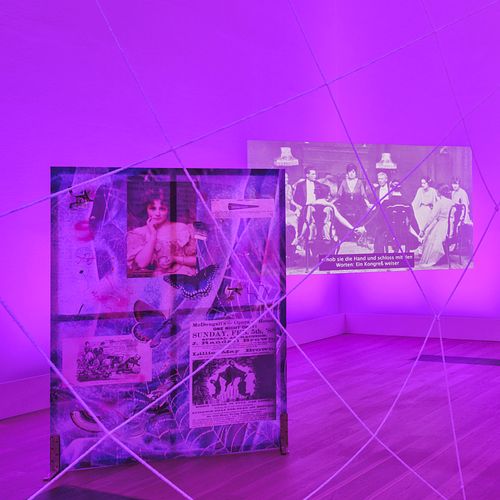AUDIO
Cordula Ditz
The purple and pink light in Cordula Ditz’s installation must have caught your eye as soon as you entered the exhibition space. It forms its own body of light in the gallery, attracting attention and evoking the color of mystery—and of the occult. In the center there is a large spider web. This reinforces the impression that we are dealing with supernatural forces here.
In the video The Weak Lips of a Woman, Cordula Ditz takes you to Lily Dale, a small community in Upstate New York. Since the nineteenth century, Lily Dale has had a reputation as a center of spiritualism—a religious movement whose followers believe in the afterlife and ghosts, and attempt to communicate with them. Ditz worked there as a documentary filmmaker and combined present-day footage with historical material.
Her works center around the figure of the medium, and the ways in which women used that role in the nineteenth century to speak publicly and exert influence. Spiritualists regarded women as particularly receptive to messages from the afterlife. In the spirit of self-empowerment, these women used this status to establish a higher level of equality.
Next to the video, you can see five images printed and painted on transparent fabric. These images feature motifs like ghost trumpets, butterflies, manicured hands, historical documents, and portraits of women’s rights activists, but also caricatures that ridicule them. Certain details—such as finger tattoos or hair—appear over and over again. You may even discover them in other works in the exhibition …
Cordula Ditz focuses less on the spectacle of the occult than on the social background behind it. Her installation shows the links between spiritualism and the women’s movement—and the ways in which women carved out new spaces for themselves in a world dominated by men.
In the video The Weak Lips of a Woman, Cordula Ditz takes you to Lily Dale, a small community in Upstate New York. Since the nineteenth century, Lily Dale has had a reputation as a center of spiritualism—a religious movement whose followers believe in the afterlife and ghosts, and attempt to communicate with them. Ditz worked there as a documentary filmmaker and combined present-day footage with historical material.
Her works center around the figure of the medium, and the ways in which women used that role in the nineteenth century to speak publicly and exert influence. Spiritualists regarded women as particularly receptive to messages from the afterlife. In the spirit of self-empowerment, these women used this status to establish a higher level of equality.
Next to the video, you can see five images printed and painted on transparent fabric. These images feature motifs like ghost trumpets, butterflies, manicured hands, historical documents, and portraits of women’s rights activists, but also caricatures that ridicule them. Certain details—such as finger tattoos or hair—appear over and over again. You may even discover them in other works in the exhibition …
Cordula Ditz focuses less on the spectacle of the occult than on the social background behind it. Her installation shows the links between spiritualism and the women’s movement—and the ways in which women carved out new spaces for themselves in a world dominated by men.
